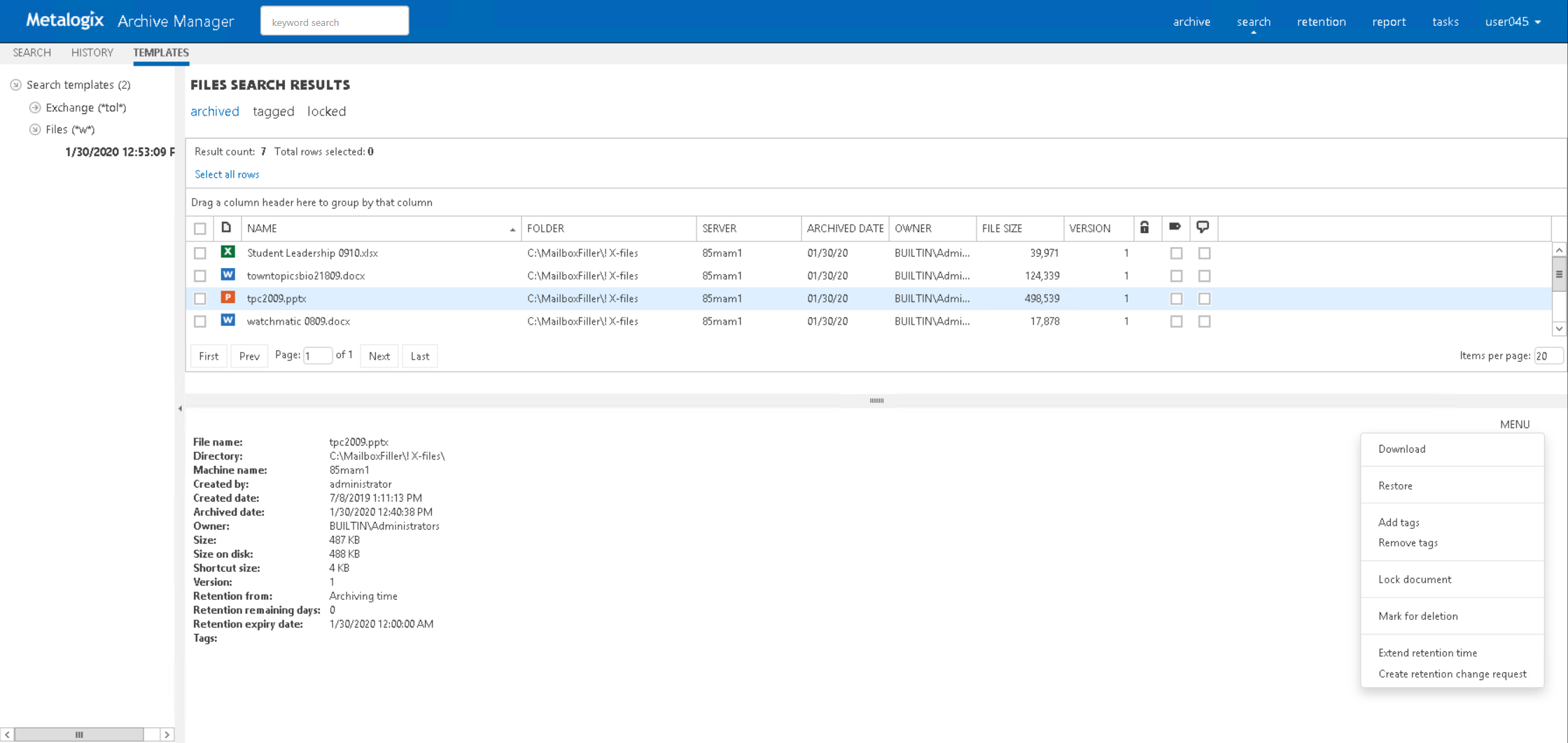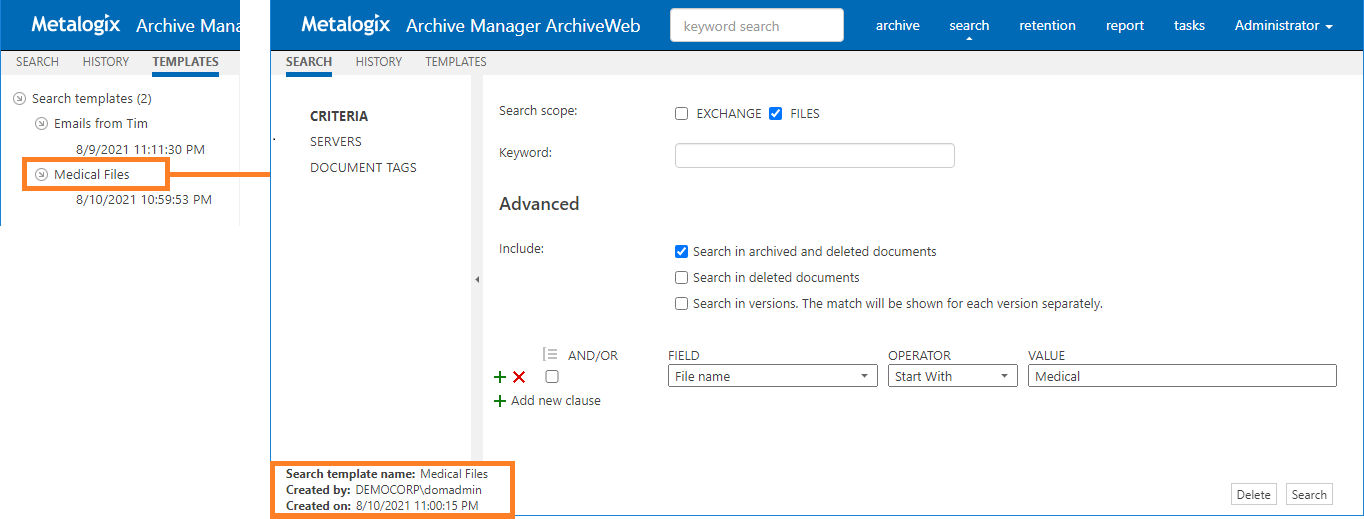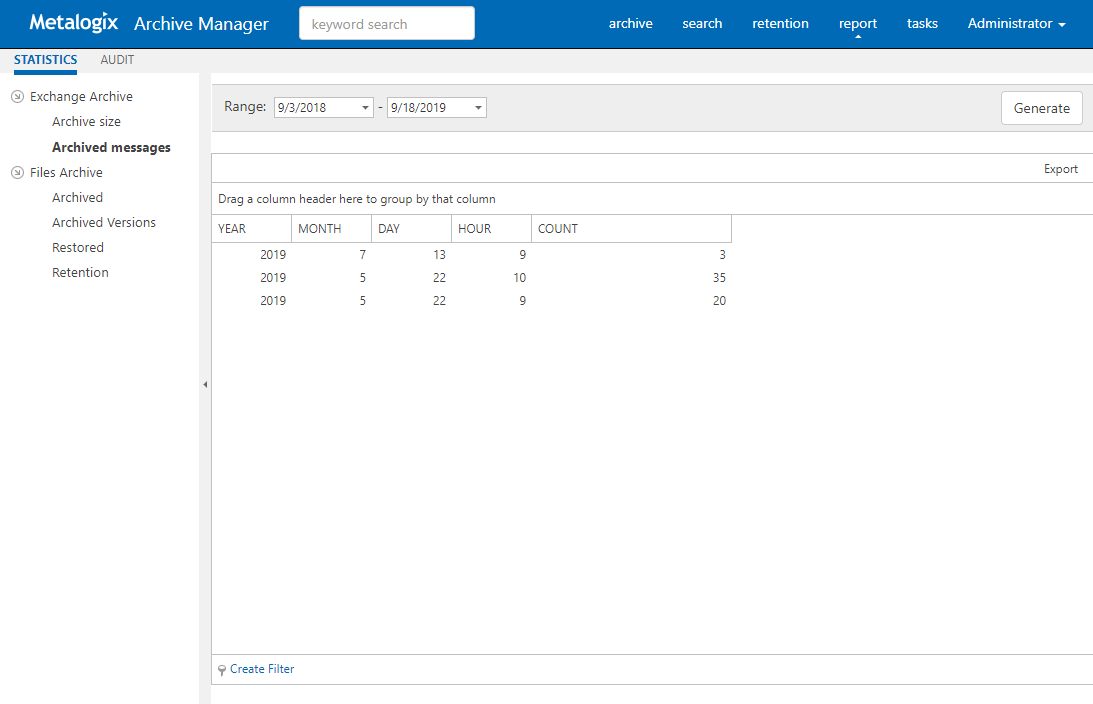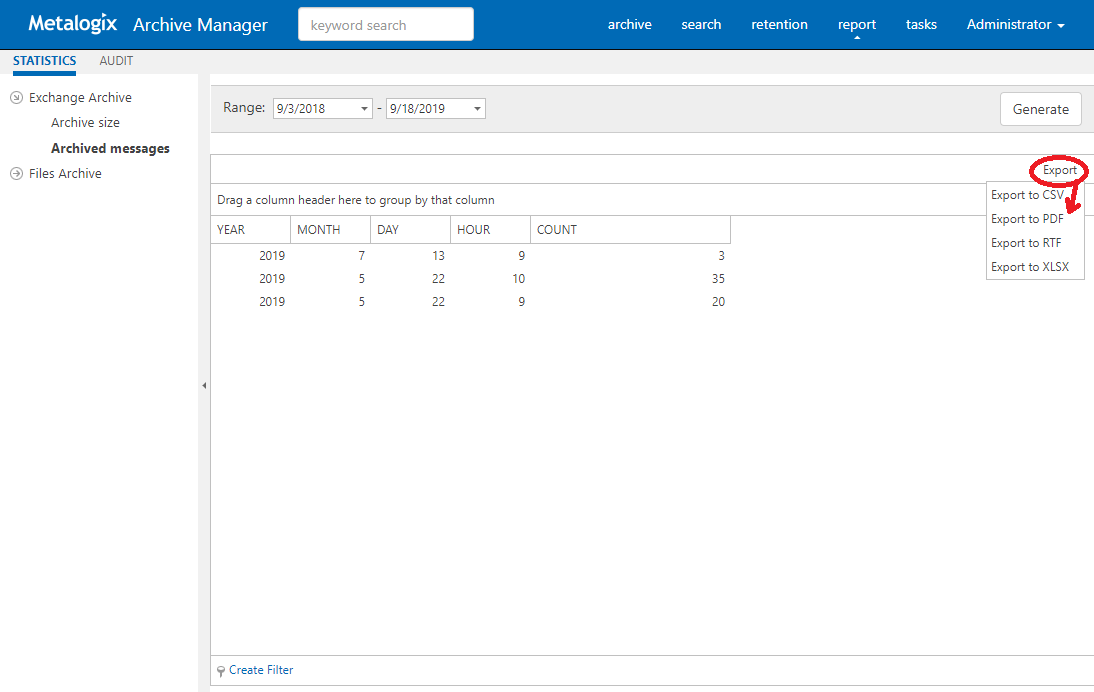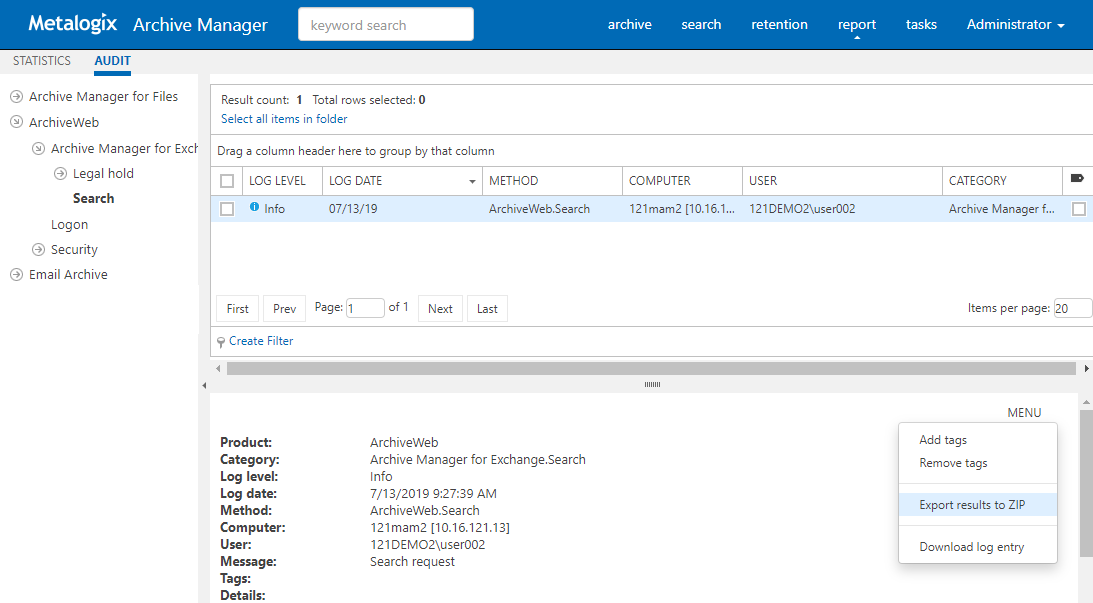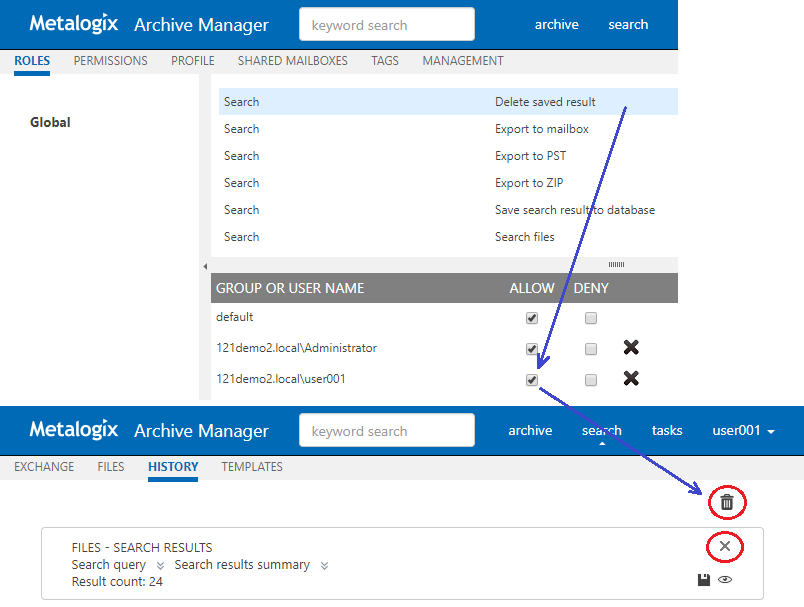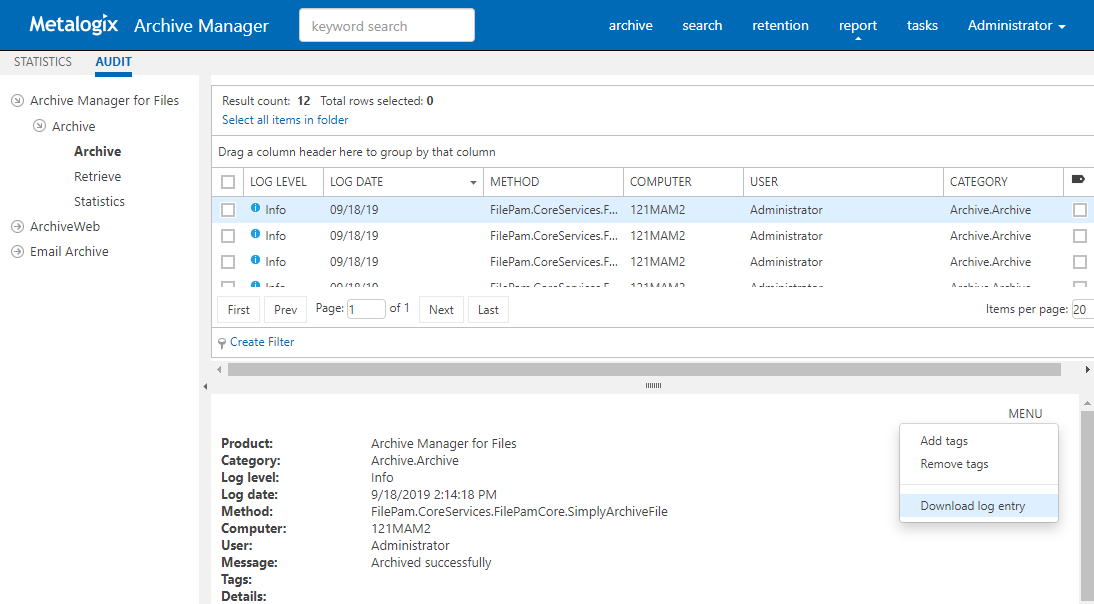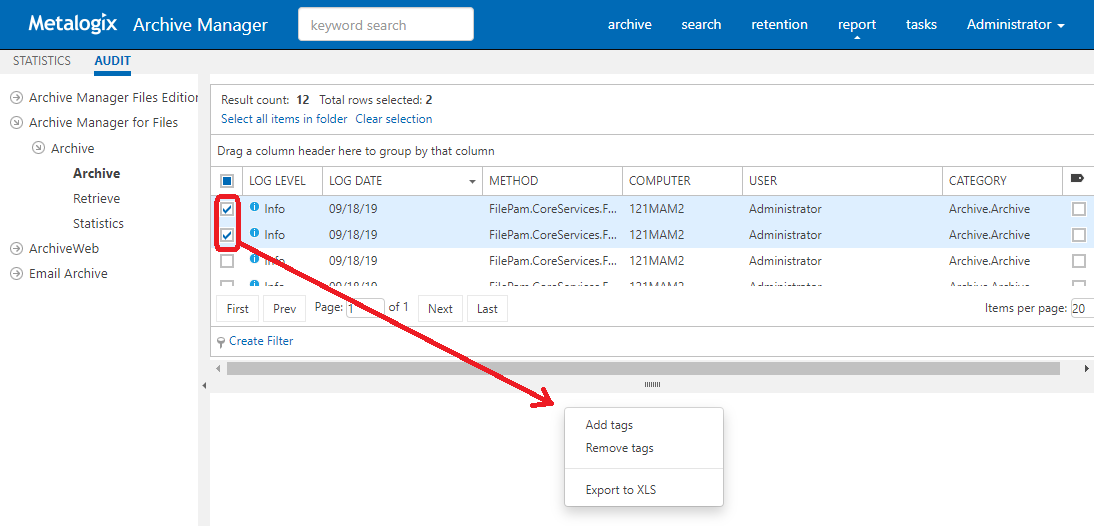Search Templates
When you expand the Search / Templates node, you may see a list of search templates that have been saved so far (search results can be saved from History tab as described in the History section).
Click on the arrow next to the template to expand the template node. Under this node you will see the link to respective search results - with the date and time when they were saved.
Clicking the search results link will display the search results in the main pane. Here you can benefit from the filtering functionality as in all ArchiveWeb lists grouping, filtering by status (tagged, locked etc.) and creating custom filters.
The MENU link in the top right corner of the item detail pane offers additional actions for the selected item:
·Download download the selected item.
·Restore restore the selected archived item to original item.
·Add tags or Remove tags adds or removes a tag from the selected item.
·Lock/Unlock document locks or unlocks selected item.
·Mark for deletion marks the selected item for deletion. The item will be deleted according to the retention category in use.
·Extend retention time increase the time for which the item cannot be deleted from the archive. Setting shorter retention than the actual retention is not supported. After the specified period (in months) the item can be deleted manually or by a Delete job if such is scheduled in respective Enterprise Manager.
·Create retention change request send a request to the approving person for selected item deletion or increased retention time when it can't be deleted from the archive. The Approver who is the person with adequate permission in Archive Manager, will receive the request through email notification if Archive Manager SMTP is properly configured.
Templates handling
When you click on any template name under the Templates node, ArchiveWeb redirects you to the given search criteria page. It can be either Exchange, Files or Common search depending on the template. All search criteria are configured by the template. You can click Search to perform the same search with the search settings specified in this template.
On the screenshot below you can see how the template is displayed once you click its name under the Templates node. The main pane presents the usual Exchange/Files/Common search window. The only difference is the bottom part of the windows. There you see the template metadata (name, user, date of creation etc.) and action buttons:
·Search runs search query
·Delete deletes the template completely from the Templates node
Report
With Report functionality at hand, users have overview of their email and/or file archives. Clear concise information in terms of how many items were archived, when, what is their size original or shortcut etc. Files features also information on retrieved items.
Report section consists of two tabs - Statistics tab with information on archived emails/items and Audit tab with logs of user actions.
Please note that full access to this functionality must be granted to the user under Permissions (see the Roles & Permissions section).
Statistics
This tab was designed to give the administrator fast, reliable and comprehensive information about archived emails/files. The number of emails/files, their size as well as space saved on the disc at archiving all these essential data can be sorted by folder, user or time period. Exporting the statistics is also possible.
Statistics are available for:
oExchange Archive
oFiles Archive
NOTE: Not all Statistics functions may be available for the logged-on user. The user must be granted the necessary permissions. For more information see the Roles and Permissions sections.
Exchange Archive statistics
To generate the Archive Manager for Exchange statistics click on the Report from the main menu bar. Then form the grey sub-bar click Statistics and unfold the Exchange Archive node. Then select whether you want to display statistics for:
·Archived messages (count of messages) or
·Archived size (size of original message; shortcut size etc.)
NOTE: Date range selection is also possible (to improve performance). The statistics can be generated also in Archive Manager for Exchange Enterprise Manager.
Files Archive statistics
To generate the Archive Manager for Files statistics click on the Report from the main menu bar. Then form the gray sub-bar click Statistics and unfold the Files Archive node. Then select whether you want to display statistics for:
·Archived (details on archived files) or
·Restored (detailed on restored files)
·Archived versions (details on files with versions in the archive)
·Retention (details on files whose retention ends at the listed date) - a new column Retention remaining days and pagination have been added
NOTE: The statistics can be generated also in Archive Manager for Files Enterprise Manager.
Statistics table functions are similar to ArchiveWeb table functions:
ØChange the column sorting order by selecting the given column header and clicking its down/up arrow on the right (in case the arrow is not visible adjust the width of the column by dragging the line)
ØGroup table data by any column. To do so, drag the column header to the bar right above the table. Generated groups can be expanded by clicking the arrows next to them. As usual, the sorting order can be changed by clicking the little arrow in the dragged column header.
To export the data, click Export at the top-right of the table. The Export menu opens and you can choose to export the statistics to Excel, CSV, PDF or RTF.
Audit tab
This tab is accessible if:
·Auditing is configured (see the Auditing manual) and
·logged-on user has Auditing permissions activated
Auditing feature allows administrator (or other users defined in web config) to log defined user actions in the email archive, i.e. the administrator has an overview of archived / restored / retrieved emails and performed keyword searches. Even all actions made in Enterprise Manager console (both for Archive Manager for Exchange and for Files) are logged.
To view the logs, from the main pane click Report, then Audit from the grey sub-bar. Then unfold the Email Archive node to access the Archive Manager for Exchange logs or Archive Manager for Files node to access the Archive Manager for Files logs. Then you can browse through different types of logs archive actions (Archive node), retrieve actions (Retrieve node) etc.
NOTE: Not all Audit tab functions may be available for the logged-on user. The functions must be allowed for the user. For more information see the Roles and Permissions sections.
The log entries of the selected action are displayed in the main pane. Data of the log entry selected in the main pane are displayed below the list view (see the screenshot above).
Audit Search
Special settings are available for Email Archive/ Search logs. Every search action is logged in the auditing log. By default user sees only its own search result logs displayed. To make all users search logs available for the user, s/he must have Access all mailboxes permission allowed for Auditing (under <LoggedOnUser>/ Manage Settings/ Roles).
To check your auditing search:
1.Perform search
2.Preview and export the search result by permission
3.deactivate the Delete functionality for user (under <Logged on user> / Manage settings / Roles)
List view conventions
List view functions are the same as in other ArchiveWeb lists:
ØChange the column sorting order by selecting the given column header and clicking its down/up arrow on the right (in case the arrow is not visible adjust the width of the column by dragging the line)
ØGroup table data by any column. To do so, drag the column header to the bar right above the table. Generated groups can be expanded by clicking the arrows next to them. As usual, the sorting order can be changed by clicking the little arrow in the dragged column header.
Any audit entry can be downloaded or tags can be added or removed from it. All tasks are available through the More actions menu. Click the More actions menu button located on the bottom right just below the list view. Then you can e.g:
·Add tags or Remove tags : these options allow you to add or remove tags from selected items (for more information on tags see the Tagged items tab section)
·Export results to ZIP (only for ArchiveWeb/Archive Manager for Exchange/Search or ArchiveWeb/Archive Manager for Files/Search entries); this option will export search result items with summary to Excel file and allow to download the created ZIP to the user's local machine.
|
|
NOTE: This function is only available if the user has Export results to ZIP role allowed for Audit (under <LoggedOnUser>/ Manage Settings/ Roles). |
·Export to XLS: this option will export selected items to XLS file on the user's local machine and provide a download link to the same file.
|
|
NOTE: When downloading large amount of items it is reasonable to split the data in more XLS files. To do this value for the key "ItemsPerXLS" needs to be changed in ArchiveWeb's web.config file.The default value is "500000" and represents number of rows for single XLS file during the export. In order to set correct value for the key please refer to Excel limits on the page https://support.office.com/en-us/article/excel-specifications-and-limits-1672b34d-7043-467e-8e27-269d656771c3. |
·Download log entry: this option will download single log entry in log file format on user local machine.
When two or more items are checked, the More actions menu appears automatically under the list view.
For more information on Auditing (how to install, configure it etc.) see the Auditing manual.


